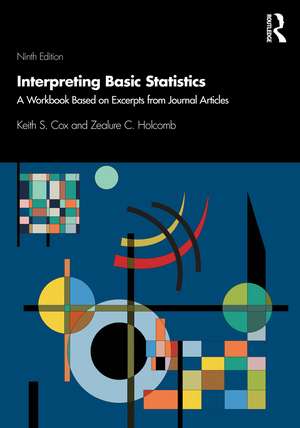Interpreting Basic Statistics: A Workbook Based on Excerpts from Journal Articles
Autor Zealure C. Holcomb, Keith S. Coxen Limba Engleză Paperback – 30 sep 2021
Interpreting Basic Statistics gives students valuable practice in interpreting statistical reporting as it actually appears in peer-reviewed journals.
Features of the ninth edition:
- Covers a broad array of basic statistical concepts, including topics drawn from the New Statistics
- Up-to-date journal excerpts reflecting contemporary styles in statistical reporting
- Strong emphasis on data visualization
- Ancillary materials include data sets with almost two hours of accompanying tutorial videos, which will help students and instructors apply lessons from the book to real life scenarios
About this book
Each of the 63 exercises in the book contain three central components: 1) an introduction to a statistical concept, 2) a brief excerpt from a published research article that uses the statistical concept, and 3) a set of questions (with answers) that guides students into deeper learning about the concept.
The questions on the journal excerpts promote learning by helping students
- interpret information in tables and figures,
- perform simple calculations to further their interpretations,
- critique data-reporting techniques, and
- evaluate procedures used to collect data.
The questions in each exercise are divided into two parts: (1) Factual Questions and (2) Questions for Discussion. The factual questions require careful reading for details, while the discussion questions show that interpreting statistics is more than a mathematical exercise. These questions require students to apply good judgment as well as statistical reasoning in arriving at appropriate interpretations.
Each exercise covers a limited number of topics, making it easy to coordinate the exercises with lectures or a traditional statistics textbook.
| Toate formatele și edițiile | Preț | Express |
|---|---|---|
| Paperback (1) | 461.21 lei 6-8 săpt. | |
| Taylor & Francis – 30 sep 2021 | 461.21 lei 6-8 săpt. | |
| Hardback (1) | 1243.57 lei 3-5 săpt. | +20.62 lei 6-12 zile |
| Taylor & Francis – 30 sep 2021 | 1243.57 lei 3-5 săpt. | +20.62 lei 6-12 zile |
Preț: 461.21 lei
Preț vechi: 542.61 lei
-15% Nou
88.26€ • 94.37$ • 73.58£
Carte tipărită la comandă
Livrare economică 18 aprilie-02 mai
Specificații
ISBN-10: 0367561972
Pagini: 258
Ilustrații: 44 Tables, black and white; 18 Line drawings, black and white; 18 Illustrations, black and white
Dimensiuni: 178 x 254 x 14 mm
Greutate: 0.46 kg
Ediția:Nouă
Editura: Taylor & Francis
Colecția Routledge
Locul publicării:Oxford, United Kingdom
Public țintă
Postgraduate and UndergraduateCuprins
Notă biografică
Recenzii
"This introduction to reading and understanding statistics is very basic and easy to understand, but at the same time it is scientifically oriented, contemporary in outlook and forward looking in methodology. It points students in exactly the right direction, emphasizing meaningful interpretation of scientific results over recitation of cookbook formulas. Students will come away with the tools they need for comprehending graphical analysis, effect size, and statistical power." -- Eric Turkheimer, PhD, Hugh Scott Hamilton Professor, Department of Psychology, University of Virginia, USA
Descriere
Interpreting Basic Statistics gives students valuable practice in interpreting statistical reporting as it actually appears in peer-reviewed journals.
Features of the ninth edition:
- Covers a broad array of basic statistical concepts, including topics drawn from the New Statistics
- Up-to-date journal excerpts reflecting contemporary styles in statistical reporting
- Strong emphasis on data visualization
- Ancillary materials include data sets with almost two hours of accompanying tutorial videos, which will help students and instructors apply lessons from the book to real life scenarios
About this book
Each of the 63 exercises in the book contain three central components: 1) an introduction to a statistical concept, 2) a brief excerpt from a published research article that uses the statistical concept, and 3) a set of questions (with answers) that guides students into deeper learning about the concept.
The questions on the journal excerpts promote learning by helping students
- interpret information in tables and figures,
- perform simple calculations to further their interpretations,
- critique data-reporting techniques, and
- evaluate procedures used to collect data.
The questions in each exercise are divided into two parts: (1) Factual Questions and (2) Questions for Discussion. The factual questions require careful reading for details, while the discussion questions show that interpreting statistics is more than a mathematical exercise. These questions require students to apply good judgment as well as statistical reasoning in arriving at appropriate interpretations.
Each exercise covers a limited number of topics, making it easy to coordinate the exercises with lectures or a traditional statistics textbook.
